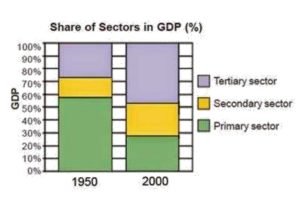NCERT Solutions for Social Economics Class 10 Chapter 2
NCERT Solutions for Class 10
Social Science (Economics)
Chapter 2 – Sectors of the Indian Economy
1. Fill in the blanks using the correct option given in the bracket:
i) Employment in the service sector ______ increased to the same extent as production. (has/has not)
Answer: Has not
ii) Workers in the _____ sector do not produce goods. (tertiary/agriculture)
Answer: Tertiary
iii) Most of the workers in the _____ sector enjoy job security. (organised/unorganised)
Answer: Organised
iv) A _____ proportion of labourers in India are working in the unorganised sector. (large/small).
Answer: Large
v) Cotton is a _____ product and cloth is a _______ product. (natural/manufactured)
Answer: Natural
vi) The activities in primary, secondary and tertiary sectors are ______. (independent/interdependent)
Answer: Interdependent
2. Choose the most appropriate answer.
a) The sectors are classified into public and private sector on the basis of:
i) Employment conditions
ii) The nature of economic activity
iii) Ownership of enterprises
iv) Number of workers employed in the enterprise
Answer: Option iii) ownership of enterprise
b) Production of a commodity, mostly through the natural process, is an activity in _____ sector.
i) Primary
ii) Secondary
iii) Tertiary
iv) Informative technology
Answer: Option i) Primary
c) GDP is the total value of ______ produced during a particular year.
i) All goods and services
ii) All final goods and services
iii) All intermediate goods and services
iv) All intermediate and final goods and services
Answer: Option ii) All final goods and services
d) In terms of GDP the share of tertiary sector in 2003 is _____
i) Between 20 per cent to 30 per cent
ii) Between 30 per cent to 40 per cent
iii) Between 50 per cent to 60 per cent
iv) 70 per cent
Answer: Option iii) between 50 per cent to 60 per cent
3. Match the following:
| Sl No | Problem faced by farming sector | Sl No. | Some possible measeure |
| 1. | Unirrigated land | a. | Setting up agro-based mills |
| 2. | Low prices for crops | b. | Cooperative marketing societies |
| 3. | Debt burden | c. | Procurement of food grains by government |
| 4. | No job in the off season | d. | Construction of canals by the government |
| 5. | Compelled to sell their grains to the local traders soon after harvest | e. | Banks to provide credit with low interest |
Answer:
| Sl No | Problem faced by farming sector | Sl No. | Some possible measeure |
| 1. | Unirrigated land | a. | Construction of canals by the government. |
| 2. | Low prices for crops | b. | Procurement of food grains by the government. |
| 3. | Debt burden | c. | Banks provide credit with low interest. |
| 4. | No job in the off season | d. | Setting up agro-based mills |
| 5. | Compelled to sell their grains to the local traders soon after harvest | e. | Cooperative marketing societies. |
4. Find the odd one out and say why.
(i) Tourist guide, dhobi, tailor, potter
Answer: Tourist guide, appointed by the government.
(ii) Teacher, doctor, vegetable, vendor, lawyer
Answer: Vegetable vendor, since it does not require a formal education.
(iii) Postman, cobbler, solider, police constable
Answer: Cobbler – workers in the public sector, his profession belongs to the private sector.
(iv) MTNL, Indian Railways, Air India, SAHARA Airlines, All India Radio
Answer: SAHARA Airlines is a private enterprise, others are government undertaking.
5. A research scholar looked at the working people in the city of Surat and found the following.
| Place of work | Nature of emplyoment | Percentage of working people |
| In offices and factories registered with the government | Organised | 15 |
| Own shops, office, clinics in marketplace with formal license | – | 15 |
| People working on the street, construction workers, domestic workers | – | 20 |
| Working in small workshops usually not registered with the government | – | – |
Complete the table. What is the percentage of workers in the unorganised sector in this city?
Answer:
| Place of work | Nature of employment | Percentage of working people |
| In offices and factories registered with the government | Organised | 15 |
| Own shops, office, clinics in marketplace with formal license | Organised | 15 |
| People working on the street, construction workers, domestic workers | Organised | 20 |
| Working in small workshops usually not registered with the government | Unorganised | – |
The worker percentage of the unorganised sector in the city is 70%.
6. Do you think the classification of economic activities into primary, secondary and tertiary is useful? Explain how.
Answer: Yes, classification of economic activities into primary, tertiary and secondary is very much useful since it can give information on how and where the people of a country are employed.
It also helps in ascertaining, which sector of economic activity is contributing more or less in GDP of the country and per capita income.
For example: Suppose if the tertiary sector is developing much faster compared to the primary sector, it means agriculture is depleting. We can observe that the agriculture profession is getting unpopular or regressive, if we classify economic activities for smooth administration as well as development.
7. For each of the sectors that we came across in this chapter why should one focus on employment and GDP? Could there be other issues which should be examined? Discuss.
Answer: Each sector should focus on employment and GDP since these determine the size of a country’s economy. Focus on employment and GDP will definitely help in determining two important things, that is, per capita income and productivity.
So, in each sector employment rate, status and its contribution towards the GDP, which helps to understand how a particular sector is functioning and what can be done to initiate future growth.
Other related issues which need to be examined are:
● Balanced regional development
● Equality in income and wealth among all the citizens of the country.
● Modernization of technology.
● How to eradicate poverty
● Self-reliance of the country
● To have surplus food production in India.
8. Make a long list of all kinds of work that you find adults around you doing for a living. In what way can you classify them? Explain your choice.
| Sl No. | Nature of work | nature of activity | Sector |
| 1. | Bank Clerk | Tertiary | organised |
| 2. | Freelancer cartoonist | Tertiary | Unorganised |
| 3 | Construction worker | Secondary | Unorganised |
| 4 | Doctor in AIIMS | Tertiary | Organised |
| 5 | DTC bus driver | Tertiary | Organised |
| 6 | Farmer | Primary | Unorganised |
| 7 | Guest house receptionist | Tertiary | Unorganised |
| 8 | Tailoring shop | Tertiary | Unoranised |
| 9 | Public sector factory supervisor | Secondary | Organised |
We have classified them according to the nature of activity and whether they are working in an organised or unorganised sector. This gives us information on how and where people are employed.
9. How is the tertiary sector different from other sectors? Illustrate with a few examples.
Answer: The tertiary sector is different from other 2 sectors because the other two sectors produce goods, the only difference is that this sector does not manufacture goods by themselves. The activities under this sector helps in developing the primary and secondary sectors. These activities support the manufacturing process.
Example: communication, banking, storage, insurance, transport, trade etc. Hence, these are called the service sector.
10. What do you understand by disguised unemployment? Explain with an example each from the urban and rural areas.
Answer: Disguised unemployment is when the people who are visibly employed but they are actually unemployed. This kind of situation is called Hidden Unemployment.
For example:
● In rural areas, this kind of employment is found in the agriculture sector, suppose in a family of 9 people everyone is engaged and doing work in the same agricultural area. If 4 people are removed from it there will be no reduction in result. Hence, these 4 people are actually disguisedly employed.
● In urban areas, this kind of unemployment can be seen in service sectors, for example, in a family where all the members are working in a small business which can be managed by a less number of people.
11. Distinguished between open unemployment and disguised unemployment.
Answer:
| Open Uneployment | Disguised uneployment |
| If a country’s labour does not get an opportunity for adequate employment, this situation is called open unemployment. | In Disguised unemployment, people who are visibly employed but actually don’t have full employment. |
| This type of unemployment is found in the industrial sector of our country. This is also among the landless agricultural labourers in rural areas. | It is generally found in the unorganised sector where work is not continuously available or many labours are employed for the same amount of work. |
12. “Tertiary sector is not planning any significantly role in the development of Indian economy”. Do you agree? Give reasons in support of your answer.
Answer: No, I don’t agree with this statement. The tertiary sector has contributed immensely in the last two decades in the Indian economy. The information technology field has grown, and the GDP share of the tertiary sector has grown from 40% in 1973 to 50% in 2003.
13. Service sector in India employs two different kinds of people. Who are these?
Answer: Service sector in India employs:
● The people who are there in this service may directly help in production of goods. Example: people in transportation, storage, communication, finance etc.
● The people involved in these services are not directly helping in the production of goods. e.g., teachers, doctors, barbers, cobblers’ lawyers etc. They are called ancillary workers which means that those who are giving their services to the primary sector providers.
14. Workers are exploited in the unorganised sector. Do you agree with this view? Give reasons in support of your answer.
Answer: Yes, I agree workers are exploited in the unorganised sector:
● Having no fixed number of working hours. The workers work 10-12 hours without paid overtime.
● They do not get extra allowances apart from the daily wages.
● Government rules and regulations for the protection of labourers are not followed.
● No job security.
● Jobs are low paid and the workers in this sector are illiterate, ignorant and unorganised.
15. How are the activities in the economy classified on the basis of employment conditions?
Answer: Employment conditions are the basis of, the activities in the economy are classified into organised and unorganised sectors.
● Organised sector: This sector covers those enterprises that are registered by the government and have to follow rules and regulations. Example: Reliance, GAIL etc.
● Unorganised sector: It consists of small and scattered units which are not in control of the government. They do not follow any rules and regulations made by the government. Example: Casual workers in construction, shops etc. There is no job security.
16. Compare the employment conditions prevailing in the organised and unorganised sectors:
Answer: Employment conditions in the organised and unorganised sectors are quite different.
● The organised sector consists of companies registered under government, so it offers job security, paid holidays, pension, health and other benefits, fixed working hours and extra pay for overtime work.
● Unorganised sector is a host of opportunities, there is no job security as well.
● No paid holidays or pensions or retirement, no benefits of provident fund or health insurance, no fixed work timings and no guarantee of a hygienic work environment.
17. Explain the objective of implementing the NREGA 2005.
Answer: The objective of implementing NREGA 2005 are:
a) To increase income and employment of people.
b) Every state will be able to develop tourism, regional craft, IT etc.
c) Central government made a law to implement, right to work in 200 districts.
d) NREGA aims to provide 100 days of employment.
18. Using examples from your area compare and contrast that activities and functions of private and public sectors.
Answer: Public sector:
● Public welfare is the main objective.
● It is managed as well as controlled by the government.
● It provides education, health, food and security to the people like Indian railways, Post office etc.
Private sector:
● Maximum profit in terms of earning is the main objective.
● It is managed and controlled by an individual or group of individuals.
● It provides consumer goods to the people; Reliance, TISCO.
19. Discuss and fill the following table giving one example each from your area.
| Well-managed organisation | Badly-managed organisation | |
| Public sector | ||
| Private sector |
Answer:
| Well-managed organisation | Badly-managed organisation | |
| Public sector | Delhi Metro Rail Corporation | Air India |
| Private sector | Reliance Jio Telecom | Satyam |
20. Give a few examples of public sector activities and explain why the government has taken them up.
Answer:
● Public sector activities, that is, provision of water, electricity and modes of transport. The government has taken up this because water and power are needed by everyone.
● If we leave the work of providing electricity and water to the private companies, then the latter may exploit this opportunity.
● They may sell these at higher rates which the masses cannot afford.
● To make sure that all the basic amenities such as water and electricity are available for all, the government supplies all these at low and affordable rates.
21. Explain how public sector contributes to the economic development of a nation.
Answer: Public sector contributes the economic development of a nation:
● It promotes rapid economic development by creating and expanding the infrastructure.
● It creates employment opportunities.
● It generates financial resources for development.
● It ensures equal income and wealth, hence a balanced regional development.
● It encourages development of small, medium and large industries.
● It ensures easy availability of goods at affordable rates.
22. The workers in the unorganised sector need protection on the following issue: wages, safety and health. Explain with examples.
Answer: Workers in the unorganised sector require protection in terms of wages. labourers who are employed as vendors or repair men etc. do not have fixed income. They hardly get employed throughout the year.
● Safety: Workers in the unorganised sector are not provided with safe drinking water or a clean environment. Example: Working in mining, chemical industries is hazardous.
● Health: Leave is not granted if there is a health issue. Medical aid is not available, e.g., Construction workers.
23. A study in Ahmedabad found that out of 15,00,000 workers in the city, 11,00,000 worked in the unorganised sector. The total income of the city in this year (1997-1998) was Rs 60,000 million. Out of this 32,000 million was generated in the organised sector. Present this data as a table. What kind of ways should be thought of for generating more employment in the city?
Answer:
| Year | Primary | Secondary | Tertiary |
| 1950 | 80,000 | 19,000 | 39,000 |
| 2000 | 3,14,000 | 2,80,000 | 5,55,000 |
(i) Calculate the share of the three sectors in GDP for 1950 and 2000.
(ii) Show the data as a bar diagram similar to Graph 2 in the chapter.
(iii) What conclusions can we draw from the bar graph?
Answer:
Ans:
i) In 1950,
Total share of sectors in GDP = (8000+19000+39000) = 138,000 crore
Share of Primary sector = $\dfrac{80000}{138000}\times 100$ = 57.97%
Share of Secondary sector = $\dfrac{19000}{138000}\times 100$ =13.76%
Share of Tertiary sector = $\dfrac{99000}{138000}\times 100$ =28.26%
In 2000,
Total share of sectors in GDP = (314000+280000+555000) = 1149000
Share of Primary sector = $\dfrac{314000}{1149000}\times 100$ = 27.32%
Share of Secondary sector = $\dfrac{280000}{1149000}\times 100$ = 24.36%
Share of Tertiary sector = $\dfrac{555000}{1149000}\times 100$ = 48.30%
(ii) Bar graph

(iii) Conclusion drawn is that the share of the tertiary sector in the GDP has approximately doubled, the primary sector has halved. The secondary sector has increased by 10% in the last 5 years.
Study materials
- Refernce Books
- NCERT Solutions
- Syllabus







